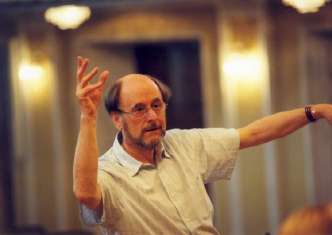|
Back
Blasts From The Classical Past New York
Isaac Stern Auditorium, Carnegie Hall
02/16/2012 -
Franz Josef Haydn: Symphony No. 39 in G Minor, Hob. I:39;
Ludwig van Beethoven: Piano Concerto No. 1 in C Major, Opus 15
Wolfgang Amadeus Mozart: Symphony No. 39 in E flat Major, K. 543
Jeremy Denk (Pianist)
Orchestra of St. Luke’s, Sir Roger Norrington (Conductor)

Sir R. Norrington (© Virgin Classics)
The concept of Late Classical music embodying elegance, balance and meadow-like placidity has obviously never occurred to either Sir Roger Norrington or Jeremy Denk. Apart in age by three decades, they evidently share the feeling that Mozart, Haydn and the young Beethoven were as fervent and passionate as the Romantics who wore hearts on their sleeves.
That was one message coming from last night’s Carnegie Hall concert, shedding light on icons writing on the cusp of 1800.
Sir Roger has been mistakenly cubbyholed as an “early-music conductor”, but he brings to early music the same excitement he shows for his Liszt and Berlioz. Jeremy Denk, in his young career, has played every style of music, but his New Yorker piece a few weeks ago about recording Charles Ives, was such a masterpiece of the authentic musical experience (and far far more revealing than Glenn Gould’s tales of the recording studio), that one could describe him as a “20th Century” guy. Nothing cold be further from the truth.
But before they paired up for an astonishing Beethoven First Piano Concerto, Sir Roger took the Orchestra of St. Luke’s through a rarer but aurally dynamic Haydn early symphony. The conductor has indeed made his name with “early music” ensembles, but some 20 years ago, he was actually Music Director for this ensemble, and they obviously play with the greatest affection. This might not have been the authentic Haydn sound, for the composer wrote for a surprising four horns, and trying to get four valveless horns to play constantly in tune would have been more than even Sir Roger was ready for.
However, he did divide the violins up, facing each other. The horn and wind soloists stood during their movements, giving more emphasis to their sounds. And the conducting was anything but classically simple. Instead, Sir Roger played every nuance in the outer movements, giving the horn quartet plenty of opportunity to sturm and drang themselves with a crisp and sometimes melodramatic sound.
The advantage of “modern” instruments, with a string section as silken as that of St. Luke’s is that a conductor like Sir Roger can bring out textures, lights and darks with the greatest subtlety. Which is exactly what he did to open the concert.
Jeremy Denk has become a star personality in the past few years. Many consider this blog to be the finest on the Net (and it is certainly both funny, incisive, personal and questing). But this is a man whose pianism rises above all. Whether his Ligeti (he played all the Etudes here just a year ago) or Bach, or Ives, he has a genuine and exuberant understanding.
That came out even before the piano entrance in the Beethoven. The shape of the stage gave one indication of interesting things to come. The orchestra was shaped in a semi-circle, with the back of Mr. Denk’s Steinway facing the audience, he facing and filling in the circle.
Sir Roger sidled through the players to stand in the middle of the circle. If he had donned top hat, cape and held a whip, he would have resembled a circus lion-tamer.
He didn’t have to tame anybody, for they all knew their parts. Even before the entrance. Mr. Denk seemed to be fondling the keys, playing with the orchestra. Once he began, Beethoven’s very pretty Concerto became an explosion of moods, and glorious runs on the piano. This was not flamboyance, not by any moods. Nor was it simply youthful exuberance by the pianist. Beethoven wrote it like a Titan trying to escape his “Classical” chains, and Mr. Denk helped him shed those chains.
But what vitality! What joy! What sensitivity in that first movement. When Mr. Denk came to the long cadenza, I wondered whether he had rewritten the original, for he offered so many moods, such galvanic action and colour that it sounded completely new.
The audience applause in this case was not the usual gaucherie, but, I feel, uncontrollable excitement at this playing.
For the finale, Beethoven marks it simply “Allegro”, but nearly every pianist these plays it like a pack of wolves are ready to pounce. I’ve never liked it this way at all, since Beethoven has so many luscious, funny, quirky moments, and the audience is distracted by hearing the speed of both artist and ensemble.
That was true, alas, with Mr. Denk. But he and Sir Roger had a good time, played together, so who am I to quibble.?
After the intermission, Mozart’s 39th Symphony was played with crisp almost martial energy. Mr. Norrington allowed St. Luke’s timpanist Maya Gunji, to lead the ceremonies, and she kept the measures as if playing a bass drum.
Good for her! It was that kind of a symphony, and Sir Roger obviously knew that nothing is effete or understated in even the most Classical of composers.
Harry Rolnick
|